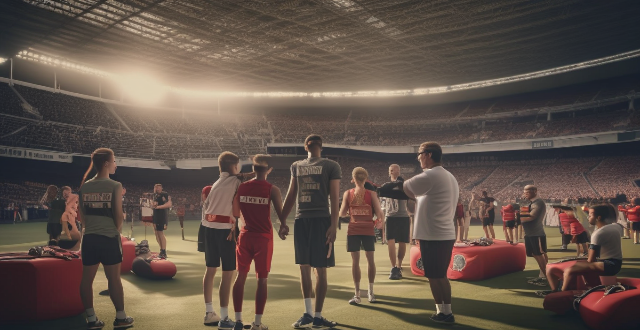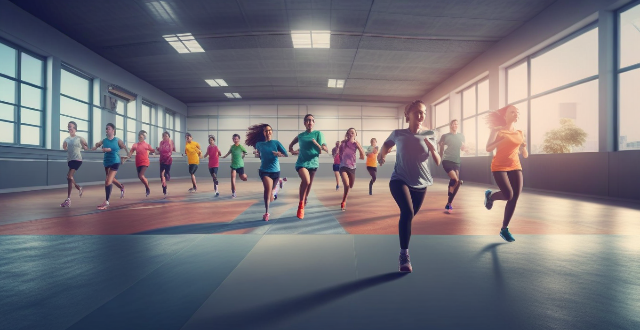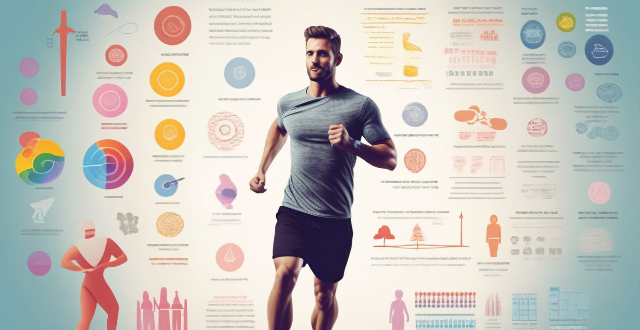Highlight Sports

Has religion ever been used to justify discrimination in sports ?
Religion has been used to justify discrimination in sports, including apartheid in South Africa, Islamic veiling and swimming, and caste-based discrimination in India. Contemporary issues include Sikh turbans and safety regulations, and Jewish holidays and scheduling conflicts. Addressing these issues requires a balance between respect for religious freedom and principles of equality and fairness in sports.

What is the impact of sports movies on the sports industry ?
Sports movies have a significant impact on the sports industry by inspiring and motivating people, promoting healthy lifestyles, generating interest in different sports, and providing marketing and branding opportunities. These movies can encourage people to pursue their dreams, work hard, and never give up, as well as highlight the importance of physical fitness and healthy living. Additionally, sports movies can generate interest in less popular or well-known sports and provide excellent marketing and branding opportunities for companies involved in the sports industry. Overall, sports movies play an essential role in shaping public perception and attitudes towards sports and physical activity.

How do I write a successful scholarship application letter ?
This guide provides tips on how to write a successful scholarship application letter, including an introduction that grabs the reader's attention and highlights academic achievements, extracurricular activities, and community involvement. The body of the letter should focus on these areas, highlighting strengths and accomplishments, while the conclusion summarizes main points and reiterates why the candidate is a strong choice for the scholarship. The closing should be polite and include contact information.

How can the media be used to increase participation in youth sports programs ?
The media can be used to increase participation in youth sports programs by creating awareness, generating interest, and providing information about opportunities available. Strategies include collaborating with local TV and radio stations for PSAs, utilizing social media platforms for short videos and infographics, live streaming sporting events, conducting interviews with coaches and athletes, creating online directories of sports programs, and hosting Q&A sessions and webinars. By leveraging the power of the media, we can inspire more young people to engage in sports and enjoy its numerous benefits.

How do sports movies influence young athletes ?
Sports movies have a significant impact on young athletes, providing motivation, inspiration, and valuable life lessons. They showcase role models who have overcome obstacles, teach the importance of perseverance and resilience, highlight teamwork and leadership, and emphasize dedication and sacrifice. These films also explore mental toughness, enjoyment of the process, and cultural impact while incorporating life lessons such as humility, respect, and integrity. However, it's important for young athletes to be aware that sports movies often present an idealized version of reality and should draw inspiration from these stories while understanding the challenges and setbacks of real-life sports.

How do you create an effective sports marketing strategy ?
Creating an effective sports marketing strategy requires a deep understanding of the target audience, the sports industry, and the brand's goals. Here are some steps to follow: 1. Identify the Target Audience: Research demographics, interests, and behaviors of potential customers. 2. Define the Brand's Goals: Set specific, measurable, achievable, relevant, and time-bound (SMART) goals. 3. Conduct Market Research: Analyze competitors, trends, and consumer preferences, and identify opportunities for partnerships or sponsorships. 4. Develop a Unique Selling Proposition (USP): Highlight the brand's strengths and benefits that resonate with the target audience. 5. Create a Marketing Mix: Tailor advertising, public relations, promotions, and sponsorships to the target audience and align with the brand's goals. 6. Measure and Evaluate Results: Track key performance indicators (KPIs) such as website traffic, social media engagement, and sales revenue to identify areas for improvement and inform future marketing strategies.

Is there potential for AI to revolutionize sports journalism and broadcasting ?
Artificial Intelligence (AI) has the potential to revolutionize sports journalism and broadcasting by automating content generation, enhancing data analysis and visualization capabilities, delivering personalized content, generating automated commentary, creating immersive VR experiences, and customizing broadcasts based on viewer preferences. AI can save time for journalists, allowing them to focus on more complex tasks such as investigative reporting or in-depth analysis. It can also uncover insights and trends from raw data and present them in visually appealing formats. Personalized content delivery can recommend articles, videos, and other content that align with individual interests. In sports broadcasting, AI can generate play-by-play commentary based on live data feeds, describe each play as it happens, and provide insightful color commentary that adds depth to the viewer's understanding of the game. Virtual reality technology can create immersive experiences that allow viewers to feel like they are part of the action. Finally, AI can customize broadcasts based on viewer preferences by analyzing user data such as viewing history and social media activity. As AI technology continues to evolve and improve, we can expect even more innovative applications in these fields that will further enhance the fan experience and change the way we consume sports content forever.

How can sports media cover events in a way that celebrates multiculturalism ?
Sports media can celebrate multiculturalism by embracing diversity in reporting, celebrating cultural traditions, promoting inclusive commentary, and educating audiences. This includes highlighting athlete backgrounds, language inclusivity, featuring pre-game and halftime shows, fan engagement, diverse commentary teams, and interactive education. By doing so, sports media can become a platform for cultural exchange and celebration, enriching the viewing experience and fostering greater understanding among diverse audiences worldwide.

What is the role of a sports medicine doctor in treating sports injuries ?
The text discusses the multifaceted role of sports medicine doctors in managing and treating sports injuries. It covers diagnosis, treatment planning, prevention strategies, assessment for returning to play, and collaboration with other health professionals. The summary should highlight the comprehensive approach of these specialists in ensuring athletes' well-being and optimal performance.

What role does cinematography play in making sports movies engaging ?
Cinematography plays a crucial role in making sports movies engaging by capturing the essence of athleticism and the drama of competition. Through the use of various filmmaking techniques, cinematographers can bring the excitement and emotions of sports to life on the screen. Here are some ways in which cinematography contributes to the appeal of sports movies: 1. Dynamic Camera Movement - Tracking shots, crane shots, and handheld shots create a sense of speed and momentum, reveal the scale of stadiums and crowds, and create an intimate, immersive experience for the viewer. 2. Creative Angles and Perspectives - Low angles make athletes appear powerful and dominant, high angles show the vulnerability or isolation of a character within a vast arena, and point-of-view shots allow the audience to see what the athlete sees, enhancing their connection to the action. 3. Lighting and Color - Contrast and shadows highlight the physicality of sport and the intensity of effort, color grading is used to convey mood, team identity, or historical eras, and backlighting creates a dramatic effect around athletes, often used in climactic moments. 4. Slow Motion and Fast Motion - Slow motion extends key moments to emphasize grace, power, or impact, while fast motion compresses time to show training sequences or build anticipation. 5. Special Effects and Visual Effects (VFX) - Chromakeying isolates athletes against different backgrounds for creative storytelling, CGI recreates historical events or enhances visually complex sports like underwater scenes, and compositing combines multiple layers of footage for dynamic scenes that couldn't be captured live. 6. Sound Design - Audio effects synch sound effects with visuals to heighten the impact of movements, and musical score supports the visuals, enhancing tension or celebration. 7. Editing Pace - Quick cuts build excitement during high-intensity moments, while long takes sustain tension during crucial plays or showcase skillful execution. 8. Storytelling through Visuals - Symbolic images use iconic sports imagery to tell stories without dialogue, and composition arranges elements within the frame to guide the audience's focus. 9. Emotional Engagement - Close-ups show facial expressions and reactions, drawing viewers into the emotional state of athletes, and environmental interaction captures interactions between athletes and their surroundings, like skimming fingers on a track or splashes in a pool. 10. Juxtaposition and Montage - Narrative montage tells backstory or parallel plotlines through a series of short, thematically connected shots, while contrast montage compares different worlds or states of mind by cutting between contrasting scenes. In summary, cinematography is not just a tool for aesthetic enhancement in sports movies; it is a language that translates the physicality, emotion, and narrative of sports into a compelling visual experience. By masterfully employing these techniques, filmmakers can transform a simple game into an unforgettable cinematic journey.

How do sports movies contribute to the overall perception and culture of sports ?
Sports movies have a significant impact on sports culture by inspiring and motivating people to engage in physical activities, promoting sportsmanship values, providing entertainment value, and serving as educational tools. They showcase the dedication and perseverance required for success in sports, often through the journey of an underdog overcoming challenges. These films also promote teamwork, fair play, and respect for opponents, highlighting the importance of sports in society and their ability to unite diverse communities. Additionally, sports movies are highly entertaining, featuring thrilling action sequences, intense competition, and compelling characters that captivate audiences. Finally, they can teach viewers about the history, rules, and techniques of various sports, enhancing knowledge and appreciation for these activities. Overall, sports movies contribute significantly to shaping our perception of athletics and encouraging participation in sports.

How do sports economists analyze the demand for sports products and services, and what factors influence this demand ?
The demand for sports products and services is analyzed by sports economists using various methods such as market research, econometric models, surveys, historical data analysis, experimental designs, social media analytics, focus groups, case studies, cross-sectional analysis, and time series analysis. Factors influencing this demand include income levels, price, population demographics, health consciousness, technology, media coverage, fashion trends, celebrity endorsements, team performance, economic conditions, government policies, social trends, and the availability and price of substitutes or complements.

What kind of contouring and highlighting techniques do stars use ?
Contouring and highlighting techniques used by stars include using bronzer for depth, highlighter for glow, concealer for shaping, powder for setting, and brushes for application. These techniques help sculpt and define facial features, creating a more chiseled and polished look.

What are some examples of sports technology analysis tools ?
Sports technology analysis tools are essential for improving performance, preventing injuries, and gaining a competitive edge in sports. These tools use advanced technologies like sensors, cameras, and software to collect, analyze, and visualize data related to sports performance. Examples of sports technology analysis tools include wearable devices, video analysis software, biomechanical assessment tools, performance tracking systems, injury prevention tools, and training apps and online platforms. These tools provide valuable insights into athletic performance, help prevent injuries, and enhance overall well-being.

How can schools incorporate sports programs to combat gaming addiction among students ?
Schools can combat gaming addiction among students by incorporating sports programs, promoting physical activity, and mental well-being. Strategies include promoting sports programs, offering a variety of sports, integrating sports into the curriculum, organizing sports events, providing access to facilities and equipment, encouraging participation in extracurricular sports clubs, educating students about the benefits of sports, and collaborating with parents and community organizations.

How is artificial intelligence being used in sports ?
Artificial intelligence (AI) is revolutionizing the world of sports, from enhancing player performance to improving fan engagement. AI technologies are helping athletes and coaches optimize their training and performance by analyzing data generated by wearable devices during training sessions, predicting injuries before they occur, and providing feedback on areas for skill improvement. AI is also transforming the way teams strategize and analyze games by providing real-time game analysis, predictive analytics, and opponent scouting. Additionally, AI is enhancing the fan experience by providing personalized content, virtual reality and augmented reality experiences, and accessibility options for people with disabilities. Overall, AI is rapidly transforming the sports industry and we can expect even more exciting developments in the future.

What challenges do filmmakers face when creating realistic sports action scenes ?
Creating realistic sports action scenes in films is a challenging task for filmmakers. They need to capture the essence of the sport while maintaining authenticity and excitement for viewers. The challenges they face include achieving accurate representation, capturing high-energy action, maintaining audience interest, enhancing visual effects, and adapting to different sports genres. By successfully overcoming these obstacles, filmmakers can deliver captivating sequences that capture the spirit of sports and leave audiences on the edge of their seats.

How does sports culture influence society's perception of health and fitness ?
Sports culture significantly influences societal perceptions of health and fitness by promoting physical activity, raising health awareness, fostering mental well-being, challenging stereotypes, and driving economic growth in the health and fitness industry. This multifaceted impact enhances individual lives and contributes to the overall well-being of communities and nations worldwide.

How do you create a sports marketing campaign that resonates with your target audience ?
Creating a sports marketing campaign that resonates with your target audience requires understanding their interests, preferences, and behaviors. Define your target audience by demographics, psychographics, and behavioral factors. Conduct market research through surveys, focus groups, and competitive analysis. Develop messaging that highlights benefits, values, and emotional appeal. Choose channels such as social media, email marketing, and events that align with your target audience's interests. Measure your results by tracking KPIs, A/B testing, and adjusting and optimizing over time.

How can we encourage more people to participate in sports activities in rural areas ?
To encourage more people to participate in sports activities in rural areas, a comprehensive approach is needed that includes infrastructure development, education and awareness, community engagement, partnerships and sponsorships, and the use of technology and media. This involves building and maintaining sports facilities, promoting the benefits of physical activity through educational programs, forming local sports clubs and leagues, seeking sponsorships from businesses and government initiatives, and utilizing digital platforms and media coverage to increase visibility and interest in sports activities.

How can writers use sports as a metaphor for larger societal issues ?
The text provides a guide on how writers can use sports as a metaphor to explore larger societal issues. The playing field in sports is likened to a microcosm of society, where fairness, equality, and justice are examined. Teamwork and collaboration in sports are used to discuss cooperation, diversity, and inclusion in society. The competitive nature of sports serves as a metaphor for the drive for success, ambition, perseverance, and the cost of success. Rules and ethics in sports are compared to societal laws and ethical standards, discussing corruption, cheating, and the importance of maintaining integrity. Finally, overcoming adversity in sports is used as a platform for stories of hope and resilience in the face of societal challenges.

How do major sporting events, like the Olympics or World Cup, influence sports-related film productions ?
The Influence of Major Sporting Events on Sports-Related Film Productions Major sporting events like the Olympics or World Cup have a significant impact on sports-related film productions. They generate increased interest in sports, provide inspiration for storytelling, offer access to athletes and coaches, and present marketing opportunities. As a result, filmmakers may be more likely to produce sports-related films during or after these events, creating works that capture the drama and excitement of sports while resonating with audiences worldwide.

How can non-disabled individuals support and advocate for greater inclusion and opportunities in sports for people with disabilities ?
Non-disabled individuals can promote inclusion and create equal opportunities in sports for people with disabilities by understanding the issues, spreading information, actively participating, advocating for policy change, promoting role models, and engaging in personal interaction.

What are some innovative ways that technology is being used in sports ?
Technology has significantly transformed various aspects of sports, including training methods, fan engagement, and game strategies. Key areas where technology is making a notable impact include virtual and augmented reality for both training and enhancing the fan experience, wearable technology for performance tracking and injury prevention, advanced analytics in player performance analysis and game strategy, video technology like instant replay and drone cameras for improved officiating and viewing experiences, eSports and gaming for interactive experiences and training simulations, social media and digital engagement for athlete interaction and live streaming, artificial intelligence in generating match highlights and aiding injury rehabilitation, and the Internet of Things in creating smart stadiums and monitoring equipment maintenance. These advancements not only improve performance but also enrich the overall sports experience for everyone involved.

How has technology influenced the design of sports fashion ?
Technology has significantly influenced sports fashion design, introducing advanced materials, digital printing techniques, smart wearables, and increased customization options. These innovations have enhanced the functionality, comfort, and style of sports apparel, catering to individual preferences and needs.

How does sports sponsorship impact the grassroots level of sports and sports development programs ?
Sports sponsorship has a significant impact on grassroots sports and sports development programs by providing financial support, resources, and exposure. Sponsorship money can be used to fund equipment, facilities, coaching, and other essential resources required for the smooth functioning of these programs. Additionally, sponsors often provide high-quality equipment, improve sports facilities, fund professional coaching, and invest in marketing and promotional activities. Sports sponsorship also provides valuable exposure opportunities for grassroots sports and sports development programs, helping them gain recognition, credibility, and attract more participants, fans, and sponsors. Overall, sports sponsorship plays a crucial role in promoting sports participation and contributing to the overall development of athletes and the sport itself.

How can parents encourage their teenagers to engage more in sports activities ?
This text offers advice for parents on how to encourage their teenagers to engage more in sports activities. It suggests setting a good example, encouraging without forcing, providing necessary support, highlighting benefits, making it social, finding the right fit, setting achievable goals, and staying involved without being overbearing. The goal is to make physical activity enjoyable for teens rather than a chore.

How does sports medicine help prevent injuries in sports ?
The text discusses how sports medicine helps in preventing injuries in sports by providing athletes with necessary knowledge, skills, and resources for maintaining their health and safety. It outlines key ways such as pre-participation physical examinations, proper warm-ups, strength training programs, correct technique, injury management, and education. These measures aim to identify risks, prepare the body for exercise, enhance fitness levels, promote safe practices, and manage injuries effectively. Overall, sports medicine plays a vital role in fostering a culture of safety and well-being within sports communities.

How does team sports impact mental health compared to individual sports ?
This article explores how team sports impact mental health compared to individual sports. It highlights the social support and belongingness provided by team sports, which can reduce feelings of isolation and loneliness. The article also discusses how team sports promote accountability and responsibility, helping individuals develop discipline and self-control. Additionally, it emphasizes the importance of goal setting and achievement in team sports, which can boost self-esteem and confidence. Overall, the article concludes that team sports have a significant impact on mental health compared to individual sports due to their social aspect.

What role does recovery play in a sports health management plan ?
Recovery is a crucial component of sports health management, enhancing performance, preventing injuries, promoting mental health, and maintaining a balanced lifestyle. It involves activities like sleep, nutrition, stress reduction techniques, and time management to ensure athletes can perform at their best while staying healthy and motivated.